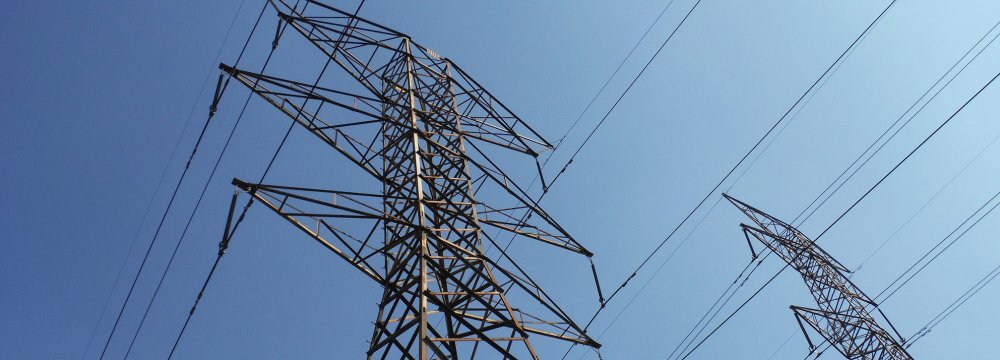
25% Rise in Iran Power Exports

"Around 5.16 million kilowatt-hours of electricity were exported to neighbors in six months compared to 4.14 million kWh in the first half of the previous fiscal, up more than 1 million kilowatt-hours,” Houshang Falahatian was also quoted as saying by IRNA.
According to the official, under swap deals, Iran exports electricity to Armenia and Azerbaijan in winter and imports it when domestic demand soars in summer.
The country trades electricity with four neighbors on its northwestern and western borders, namely Azerbaijan Republic (including Nakhchivan Autonomous Region), Turkey, Armenia and Iraq.
Highlighting Iran’s electricity consumption that reached a peak of 55,400 megawatts in July, Falahatian said that despite high domestic demand, the country has been able to fulfill all its export commitments to neighboring states during the scorching summer days.
According to a report issued by the Energy Ministry, despite the drastic increase in domestic electricity consumption, the country's revenue from power exports amounted to $3.37 billion between September 2013 and May 2017.
Falahatian added that more than 40.12 billion kilowatt hours of power were exported to neighboring states in the period. Furthermore, 54 new power plants became operational and the country's installed capacity experienced an 8,000-megawatt increase, standing at 77,000 MW.
Pointing to plans to increase the country’s power grid sustainability, the official noted that Iran has embarked on joint ventures to synchronize its electricity network with those of regional countries.
"Iran Power Generation, Distribution and Transmission Company [known as Tavanir] is in talks to synchronize Iran's electricity network with that of Iraq in a collaboration that could potentially be extended to other neighbors," he said.
"The initiative will not only pave the way to connect the electricity grid with other neighboring states, namely Jordan, Lebanon and Syria, but also enables Iran to promote its electricity exports to Pakistan and Afghanistan."
The deputy minister noted that Iraq's unpaid dues for importing Iranian electricity amounted to $800 million by August, a part of which has been cleared and the rest will be settled gradually.
Reportedly, Iran was exporting some 1,500 megawatts of electricity to its neighbor as of November 2016, when Iraq defaulted on its debt payments. Plans were to increase exports to 2,000 MW.
--- Foreign Projects
According to Alireza Daemi, deputy energy minister for international affairs, Iranian private sector contractors are undertaking 70 projects overseas.
Elaborating on the details of the project, Daemi noted that the Energy Ministry's contractors have been tasked with completing power and water ventures in Iraq, Armenia, Turkmenistan, Sri Lanka and some Latin American states.
Referring to the third electricity line that is being constructed to connect Iran and Armenia's grid, he noted that the new power line, which has already registered a work-in-progress rate of 25%, will be completed with the help of Iranian experts by the end of 2018 at an estimated cost of $107 million.
The line is part of an agreement involving Iran, Russia, Armenia and Georgia to synchronize their power grids by 2019, paving the way for electricity exchange between Tehran and Moscow as part of their cooperation plans.
Referring to renewable energy development plans, Daemi said five Norwegian firms will arrive in Tehran this week to hold talks on implementing a 120-MW renewable joint venture.


Trump weighs using $2 billion in CHIPS Act funding for critical minerals

Codelco cuts 2025 copper forecast after El Teniente mine collapse

Electra converts debt, launches $30M raise to jumpstart stalled cobalt refinery

Barrick’s Reko Diq in line for $410M ADB backing

Abcourt readies Sleeping Giant mill to pour first gold since 2014

Nevada army depot to serve as base for first US strategic minerals stockpile

SQM boosts lithium supply plans as prices flick higher

Viridis unveils 200Mt initial reserve for Brazil rare earth project

Tailings could meet much of US critical mineral demand – study

Kyrgyzstan kicks off underground gold mining at Kumtor

Kyrgyzstan kicks off underground gold mining at Kumtor

KoBold Metals granted lithium exploration rights in Congo

Freeport Indonesia to wrap up Gresik plant repairs by early September

Energy Fuels soars on Vulcan Elements partnership

Northern Dynasty sticks to proposal in battle to lift Pebble mine veto

Giustra-backed mining firm teams up with informal miners in Colombia

Critical Metals signs agreement to supply rare earth to US government-funded facility

China extends rare earth controls to imported material

Galan Lithium proceeds with $13M financing for Argentina project

Kyrgyzstan kicks off underground gold mining at Kumtor

Freeport Indonesia to wrap up Gresik plant repairs by early September

Energy Fuels soars on Vulcan Elements partnership

Northern Dynasty sticks to proposal in battle to lift Pebble mine veto

Giustra-backed mining firm teams up with informal miners in Colombia

Critical Metals signs agreement to supply rare earth to US government-funded facility

China extends rare earth controls to imported material

Galan Lithium proceeds with $13M financing for Argentina project

Silver price touches $39 as market weighs rate cut outlook

















